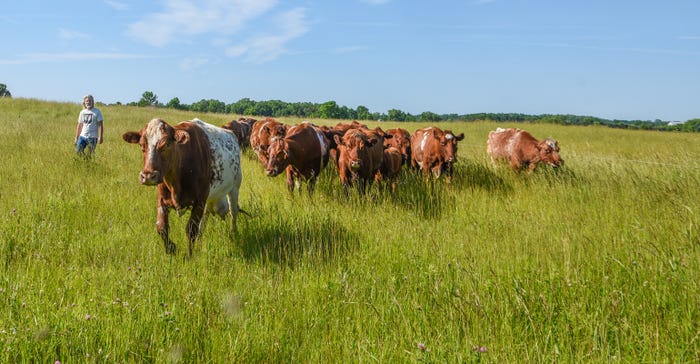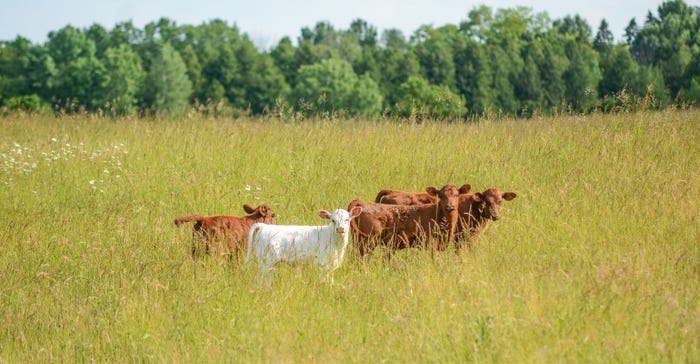September 25, 2017

Lynn and Nancy Utesch love farming, plain and simple. They’re passionate about carefully tending their 150 acres of Kewaunee, Wis., hay and pasture and their 85 head of purebred Shorthorn beef, including 25 cows and two bulls. They call it Guardians of the Field Farm.
“We really do have a passion for what we do,” says Nancy. “We love the land, we love the animals, and it’s really wonderful for us to provide a product we’ve had our hands on.”
“We really believe in farming,” echoes her husband. “It’s not just a career choice but a way of life. We love this life. But we need to encourage more young farmers. I believe farming is one of the best career choices any young person could make.”
The family, including two sons still at home — Sam, 17, and Haakon, 15 — direct-markets 100% grass-fed beef, getting it into consumers’ hands at 18 to 24 months.
Getting started
Lynn chose farming early, working on her uncle’s dairy farm near Portage, Wis.
“I just fell in love with farming,” he says. “I always had a dream of farming.”
He and Nancy started with three animals on Washington Island in Door County “and grew from there.” Finding the logistics of getting supplies and implementing marketing difficult, they moved in 2004 to their former row crop farm between Kewaunee and Algoma. They sold some animals to downsize but transported cattle, sheep, chickens, equipment, hay and the family dog — “everything we had except the hay elevator,” Lynn recalls. “It was very stressful.”
Then they had the entire 150 acres of their new farm custom-seeded to grass and laid out paddocks for rotational grazing.
“We had a very interesting couple of years waiting for the market to establish,” Lynn remembers. “Fortunately, everything worked out.”
They brought in a cattle geneticist early on to evaluate the herd and suggest which cows and bulls could best build their herd. The herd has been a closed one for 15 years. Lynn says he has enough cow families to avoid inbreeding.
“We do line breeding,” he points out, wanting “to bring back those [original] genetics” for the breed. They settled on purebred Shorthorn because Lynn had an uncle at Pardeeville who raised the breed and Lynn took a liking to it. He points to good mothers, hardiness and good marbling off grass, usually grading at choice.
“Basically, they care for themselves,” he says. “I wanted to raise purebreds and wanted them to marble well on grass. It’s really worked out well for what we do.” The herd is on pasture year-round, though shelter is available in bad weather. A portion of the land is set aside to harvest hay for winter feed. After two years, it is rotated back to pasture.
 CARING FOR CATTLE: The Utesches’ herd is on pasture year-round, though shelter is available in bad weather.
CARING FOR CATTLE: The Utesches’ herd is on pasture year-round, though shelter is available in bad weather.

Cows are pasture-bred, and calves are pasture-birthed and allowed to wean naturally. Lynn feels “that little extra milk adds gain.” The calves, he goes on, “are born strong.” He aims for fall processing to avoid keeping the market beef through a second winter.
Direct marketing
“We only sell by bulk,” Lynn continues. “It goes from us to processors and then direct to customers. We’ve been doing this for over 20 years. ... We find it very profitable when we cut out all the middlemen. With direct marketing, we capture all the profit.”
Lynn and Nancy are self-taught cattle growers. They belong to the Farmers Union. Lynn was at the first World Beef Expo in Madison, Wis., where a speaker discussing grassland farming “made perfect sense.” He continues to attend numerous conferences dealing with grassland agriculture. “We keep trying to refine what we do,” he says. “Grass has to be adapted to the local environment. It’s more art than science.”
Currently, the Utesches are overseeding some pasture land with more warm-season, drought-tolerant varieties. The 2012 drought brought on that change.
 BACK TO BASICS: Cows are pasture-bred, and calves are pasture-birthed and allowed to wean naturally.
BACK TO BASICS: Cows are pasture-bred, and calves are pasture-birthed and allowed to wean naturally.

Paddock sizes also are changeable. With this year’s heavier moisture, they are larger — roughly 33 by 500 feet. Lynn says he won’t return the herd to the season’s first paddock for 75 days. That’s unusual. The normal turnaround is 45 to 50 days in smaller paddocks. Cattle are moved to new pasture daily.
Pasture walks are popular at Guardians of the Field Farm. When available, some of the Utesches’ other five children, plus grandchildren, help out.
They also continue to raise chickens and sheep, but strictly for family use. It’s all part of doing what they love.
Buchholz lives in Fond du Lac, Wis.
About the Author(s)
You May Also Like




